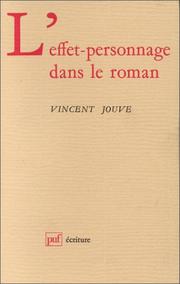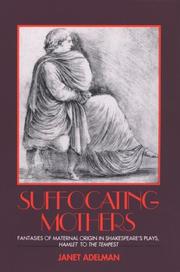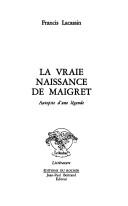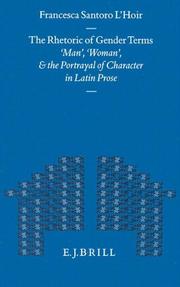| Listing 1 - 9 of 9 |
Sort by
|
Book
ISBN: 3520300087 Year: 1992 Volume: 300 Publisher: Stuttgart : Kröner,
Abstract | Keywords | Export | Availability | Bookmark
 Loading...
Loading...Choose an application
- Reference Manager
- EndNote
- RefWorks (Direct export to RefWorks)

ISSN: 02221179 ISBN: 2130442706 9782130442707 Year: 1992 Publisher: Paris Presses universitaires de France
Abstract | Keywords | Export | Availability | Bookmark
 Loading...
Loading...Choose an application
- Reference Manager
- EndNote
- RefWorks (Direct export to RefWorks)
La notion de "personnage" est l'une des plus têtues de l'analyse littéraire. Objet, dans l'après-guerre, de toutes les suspicions, elle a vaillamment survécu aux anathèmes féroces des dernières décennies. Les approches immanentes, trop strictement formelles, ou l'étude génétique, axée sur l'"avant-texte", ont cependant révélé leurs limites. Elles n'ont pu, malgré des analyses souvent remarquables, expliquer l'essentiel : la relation originale, complexe et plurielle, qui lie le personnage au lecteur de roman. Seules les théories de la lecture, actuellement en plein essor, permettent d'éclairer ce point fondamental. Elucider l'énigme du personnage, c'est en effet savoir ce qu'en fait le lecteur, comment il l'imagine, sous quel angle il l'aborde et pour quels résultats. C'est à cette étude, dont les prolongements ne touchent pas seulement à l'esthétique, mais aussi à la psychanalyse et à l'anthropologie, que cet essai est consacré.
Characters and characteristics in literature --- Reader-response criticism --- Fiction --- History and criticism --- Characters and characteristics in literature. --- -Reader-response criticism --- Reader-oriented criticism --- Reception aesthetics --- Character sketches --- Characterization (Literature) --- Literary characters --- Literary portraits --- Portraits, Literary --- Metafiction --- Novellas (Short novels) --- Novels --- Stories --- Philosophy --- Criticism --- Reading --- Littérature --- --Théorie --- --Personnage --- --Roman --- --History and criticism --- Roman --- Personnages dans la littérature --- 17.86 literary genres, theory of genre. --- Erzähltechnik. --- Esthétique de la réception. --- Fiction. --- Livres et lecture. --- Personages. --- Personnages dans la littérature. --- Personnages littéraires. --- Reader-response criticism. --- Roman. --- Romans. --- Écrivains et lecteurs. --- History and criticism. --- Histoire et critique --- Théorie, etc. --- Fiction - History and criticism --- Théorie --- Personnage --- Personnages litteraires
Book
ISBN: 351907477X Year: 1992 Volume: 28 Publisher: Stuttgart B.G. Teubner
Abstract | Keywords | Export | Availability | Bookmark
 Loading...
Loading...Choose an application
- Reference Manager
- EndNote
- RefWorks (Direct export to RefWorks)
Characters and characteristics in literature --- Personnages dans la littérature --- Theophrastus --- Theophrastus. --- Language --- Characters and characteristics in literature. --- Character sketches --- Characterization (Literature) --- Literary characters --- Literary portraits --- Portraits, Literary --- History and criticism --- Feofrast --- Theophrast --- Théophraste --- Theophrastos --- Teofrasto --- Theophrastus, --- Θεόφραστος --- Théophraste --- Personnages dans la littérature --- Language.
Book
ISBN: 2717822526 Year: 1992 Publisher: Paris Economica
Abstract | Keywords | Export | Availability | Bookmark
 Loading...
Loading...Choose an application
- Reference Manager
- EndNote
- RefWorks (Direct export to RefWorks)
Prefects (French government) --- Préfets --- 321 <44> --- #SBIB:328H212 --- Etat Staat --- Métier (fonctionnaires) Beroep (ambtenaren) --- Fonctionnaires Ambtenaren --- Valeurs (personnel) Waarden (personeel) --- Histoire de l'administration Geschiedenis van de overheid --- Personnages administratifs Administratieve figuren --- Politieke organisatie. Staten als politieke machten. Regeringsvormen--Frankrijk --- Instellingen en beleid: Frankrijk --- 321 <44> Politieke organisatie. Staten als politieke machten. Regeringsvormen--Frankrijk --- Préfets

ISBN: 0415900387 0415900395 9780415900393 9780203420652 9781136607332 9781136607370 9781136607387 9781138177161 Year: 1992 Publisher: New York, N.Y. Routledge
Abstract | Keywords | Export | Availability | Bookmark
 Loading...
Loading...Choose an application
- Reference Manager
- EndNote
- RefWorks (Direct export to RefWorks)
An original reading of Shakespeare's plays illuminating his negotiations with mothers, present and absent, and tracing the genesis of Shakespearean tragedy and romance to a psychologized version of the Fall.
Thematology --- Son --- Shakespeare, William --- Domestic drama, English --- Drama --- Fantasy in literature. --- Human body in literature. --- Masculinity in literature. --- Mothers and sons in literature. --- Psychoanalysis and literature --- History and criticism. --- Psychological aspects. --- Shakespeare, William (1564-1616) --- Shakespeare, William (1564-1616). The tempest --- Mères --- Masculinité (psychologie) --- Corps humain --- Mères et fils --- Littérature anglaise --- Psychanalyse et littérature --- Personnages --- Et la psychologie --- Dans la littérature --- 16e siècle --- Thèmes, motifs

ISBN: 2268013774 9782268013770 Year: 1992 Publisher: Paris Rocher
Abstract | Keywords | Export | Availability | Bookmark
 Loading...
Loading...Choose an application
- Reference Manager
- EndNote
- RefWorks (Direct export to RefWorks)
Simenon, Georges --- Commissaire Maigret (Personnage fictif) --- Maigret, Jules (Fictief personage) --- Maigret, Jules (Fictitious character) --- Maigret, Jules (Personnage fictif) --- Parijs in de literatuur --- Paris (France) in literature --- Paris dans la littérature --- Police dans la littérature --- Police in literature --- Politie in de literatuur --- Simenon, Georges, --- Critique et interprétation. --- Personnages --- Maigret. --- Police in literature. --- Critique et interprétation. --- Characters --- SIMENON (GEORGES), 1903-1989 --- MAIGRET --- Littérature policière --- Analyse littéraire --- Comissaire Jules Maigret
Book
ISBN: 2804115283 2801110043 9782804115289 Year: 1992 Volume: vol *117 Publisher: Bruxelles De Boeck-Duculot
Abstract | Keywords | Export | Availability | Bookmark
 Loading...
Loading...Choose an application
- Reference Manager
- EndNote
- RefWorks (Direct export to RefWorks)
Bandes dessinées --- Lecture --- Lezen --- Manuels scolaires --- Methodologie --- Méthodologie --- Schoolboeken --- Strips --- Personnages de bandes dessinées, dessins animés, etc. --- Bandes dessinées en éducation --- Histoire et critique --- #KVHA:Stripverhalen; Frans --- #KVHA:Leesvaardigheid; Frans --- Communication graphique Grafische communicatie --- Communication visuelle Visuele communicatie --- Littérature Literatuur --- Histoire Geschiedenis --- Méthodes Methoden --- Sociology of literature --- Graphic arts --- beeldverhalen --- comics [documents] --- Comic books, strips, etc. --- Bandes dessinées --- History and criticism --- Bandes dessinées en éducation. --- Histoire et critique.
Book
ISBN: 3525251963 9783525251966 Year: 1992 Volume: 97 Publisher: Göttingen Vandenhoeck und Ruprecht
Abstract | Keywords | Export | Availability | Bookmark
 Loading...
Loading...Choose an application
- Reference Manager
- EndNote
- RefWorks (Direct export to RefWorks)
Body [Human ] in literature --- Caractères litteraires --- Caractères littéraires --- Character sketches--History and criticism --- Characterization (Literature) --- Characters [Literary ] --- Characters and characteristics in literature --- Corps humain dans la littérature --- Human body in literature --- Karakterisering (Literatuur) --- Karakters [Literaire ] --- Karakters in de literatuur --- Karakterschetsen in de literatuur --- Lichaam [Menselijk ] in de literatuur --- Literaire karakters --- Literaire portretten --- Literary characters --- Literary portraits --- Littérature--Personnages --- Menselijk lichaam in de literatuur --- Personages in de literatuur --- Personnages (littérature) --- Personnages littéraires --- Portraits [Literary ] --- Portraits littéraires --- Portretten [Literaire ] --- Types littéraires --- Homer --- Homer. --- Characters and characteristics in literature. --- Epic poetry, Greek --- Description (Rhetoric) --- Rhetoric, Ancient. --- History and criticism. --- History --- -Description (Rhetoric) --- Rhetoric, Ancient --- Classical languages --- Greek language --- Greek rhetoric --- Latin language --- Latin rhetoric --- Descriptive writing --- Rhetoric --- Greek epic poetry --- Epic poetry, Classical --- Greek poetry --- Character sketches --- Portraits, Literary --- History and criticism --- -Characters --- -Hóiméar --- Hūmīrūs --- Homeros --- Homerus --- Gomer --- Omir --- Omer --- Omero --- Ho-ma --- Homa --- Homérosz --- האמער --- הומירוס --- הומר --- הומרוס --- هومر --- هوميروس --- 荷马 --- Ὅμηρος --- Гамэр --- Hamėr --- Омир --- Homero --- 호메로스 --- Homerosŭ --- Homērs --- Homeras --- Хомер --- ホメーロス --- ホメロス --- Гомер --- Homeri --- Hema --- Pseudo-Homer --- Pseudo Omero --- Characters --- -Homer --- Homère --- Ancient rhetoric --- Characters. --- Technique --- Hóiméar --- Epic poetry, Greek - History and criticism. --- Description (Rhetoric) - History - To 1500.

ISBN: 9004095128 9004329161 9789004095120 Year: 1992 Volume: 120 Publisher: Leiden Brill
Abstract | Keywords | Export | Availability | Bookmark
 Loading...
Loading...Choose an application
- Reference Manager
- EndNote
- RefWorks (Direct export to RefWorks)
The aim of this work is to recover classical Roman assumptions about women on the basis of the surviving linguistic data. The author provides a control to her study of the connotations of the major Latin words for women in the form of a corresponding examination of how Roman authors use the various words for men. The resulting analysis throws light not only on Roman gender vocabulary but also on Roman cultural perceptions of class, moral worth and nationality. Furthermore, the author's detailed discussions of strictly linguistic evidence enable her to offer several original and persuasive insights about the traditional Latin literary representation of women. Understanding the connotative range of gender terms such as homo , vir , femina , mulier also reveals the value judgments made by ancient authors on male and female behaviour and can even be applied as a tool of historical analysis.
Lexicology. Semantics --- Classical Latin literature --- Literary rhetorics --- Classical Latin language --- Characters and characteristics in literature --- Latin prose literature --- Rhetoric, Ancient --- Sex --- Sex role in literature --- Personnages dans la littérature --- Prose latine --- Rhétorique ancienne --- Sexualité --- Rôle selon le sexe dans la littérature --- History and criticism --- Terminology --- Histoire et critique --- Terminologie --- Rome --- Rome dans la littérature --- In literature --- Characters and characteristics in literature. --- Sex role in literature. --- Rhetoric, Ancient. --- History and criticism. --- Terminology. --- -Rhetoric, Ancient --- Rome in literature --- -Sex role in literature --- Gender (Sex) --- Human beings --- Human sexuality --- Sex (Gender) --- Sexual behavior --- Sexual practices --- Sexuality --- Sexology --- Classical languages --- Greek language --- Greek rhetoric --- Latin language --- Latin rhetoric --- Latin literature --- Character sketches --- Characterization (Literature) --- Literary characters --- Literary portraits --- Portraits, Literary --- Rhetoric --- Rome in literature. --- Personnages dans la littérature --- Rhétorique ancienne --- Sexualité --- Rôle selon le sexe dans la littérature --- Rome dans la littérature --- Antiquity --- Ancient rhetoric --- In literature. --- Latin prose literature. --- Literature. --- Sex. --- Belles-lettres --- Western literature (Western countries) --- World literature --- Philology --- Authors --- Authorship --- Rome (Empire) --- Rim --- Roman Empire --- Roman Republic --- Romi (Empire) --- Byzantine Empire --- Italy --- Latin prose literature - History and criticism. --- Sex - Terminology. --- Rhetorique --- Gender roles --- Literature --- Language use --- Images of women --- Book
| Listing 1 - 9 of 9 |
Sort by
|

 Search
Search Feedback
Feedback About UniCat
About UniCat  Help
Help News
News